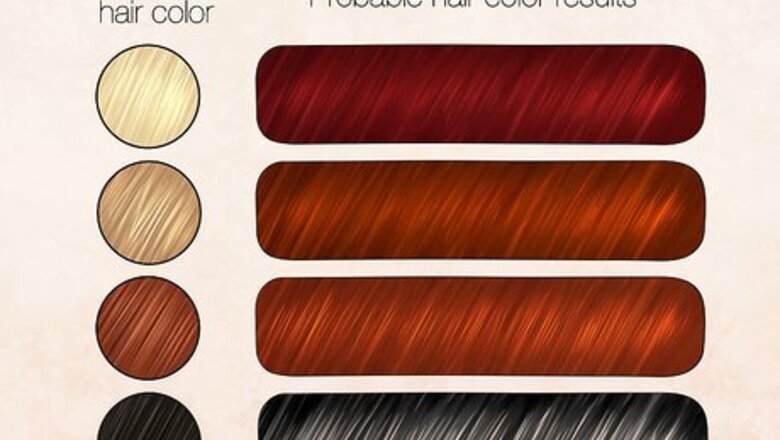
views
Preparing the Henna
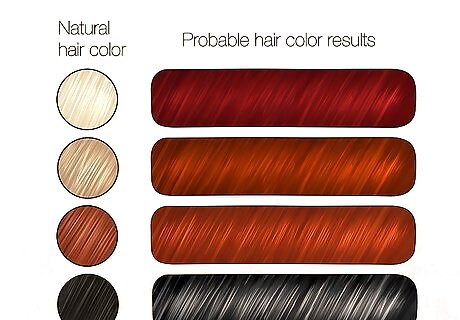
Consider your natural hair color. While true henna has a reddish, coppery tone, the color is translucent so it blends with your hair color. That means it won’t look the same on everyone. The lighter your natural hair color, the more vivid red your hair will be. With very dark hair, henna likely won’t impart much color, so you’ll just wind up with added shine. Pale blonde, gray, and white hair will wind up with a true, vibrant red shade. Mid-tone hair colors, such as dirty blonde and light brown, typically turn a richer, almost auburn shade. If you have red or auburn hair, you likely won’t see much change with henna. However, it can enhance the natural tones in your hair and cover grays. Dark hair shades, including chocolate brown and black, won’t see any real color change with henna, but your locks will look shinier and glossier afterward. If you do have some grays mixed in with your natural color, keep in mind that you won’t wind up with a uniform color. The henna will make the gray pieces appear like highlights, which can be a nice look with light and mid tone hair shades. With dark hair, though, the red highlights may look strange.

Measure out your henna. The amount of henna that you’ll need depends on the length of your hair because the longer your hair is, the more henna you’ll need. Henna powder is typically available in boxes, but you can also purchase it as a brick. Read the package instructions carefully to determine how much henna you’ll need. If you have short hair no longer than your chin, a 100-gram box of henna is usually enough. For shoulder-length hair, start with 200 grams of henna. If your hair is past your shoulders, you’ll want to have at least 300 grams of henna on hand. For extremely long hair, you may need as much as 500 grams of henna to color your entire head. Make sure that you're using natural henna powder—there are a lot of artificial ones out there.

Mix your henna in a bowl with liquid. Warm water is the most common liquid to combine with the powder, and you’ll want to add enough to create a thick, mud-like paste with the henna. Try to remove as many as the lumps as possible, so the mixture has a smooth texture like yogurt. You can use other liquids to mix your henna. Lemon, orange, and grapefruit juice are common alternatives. If you don’t mind the smell, vinegar is another option. You can even add essential oils to your mixture. To get the consistency right, it helps to add the liquid a little at a time so you have better control. If the mixture is too thick and stiff, you can add more liquid. It's also a good idea to have extra henna powder on hand, so you can add a little more if the mixture becomes too thin or runny. Just as with the liquid, though, add the powder in small amounts to ensure you don't overdo it.
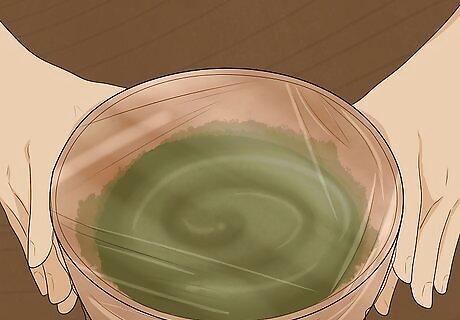
Cover your henna mixture with plastic wrap or an air tight lid. It will need to sit for at least 12 hours for the best results. Keep in mind that the longer you allow it to set, the more vibrant and red your hair will be. A dark, room temperature location is the best spot to store your henna. If you’re in a hurry and don’t want to wait 12 hours to apply your henna, try to find a warm spot to set your henna. Letting it set somewhere that’s approximately 95 degrees can have your mixture ready in two hours.
Applying the Henna

Check your henna mixture before application. It can thicken up as it sets, so you may need to moisten the mixture. Slowly add more water or your chosen liquid until the henna is back to a smooth, mud-like consistency.
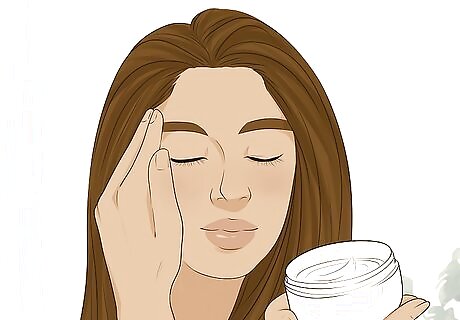
Protect yourself from stains. Henna will stain anything that it comes into contact with, including your skin, so it’s important to make sure you’re covered. Applying petroleum jelly or another thick cream or balm along your hairline, ears, and necks will prevent the henna from staining your skin. Make sure to wear rubber, latex, or some other type of protective gloves while you’re applying the mixture to your hair. Wear clothes that you don’t mind getting stained when you apply the henna because drips or spills may happen, and you won’t be able to get the color out of your clothing. It’s a good idea to apply your henna in the shower or bathtub, so you don’t have worry about getting it on your furniture, carpeting, or other surfaces. If you do get henna on your skin, wipe it away immediately. The longer that it sits on your skin, the worse the stain will be. It can take several days for a henna to fade from the skin.
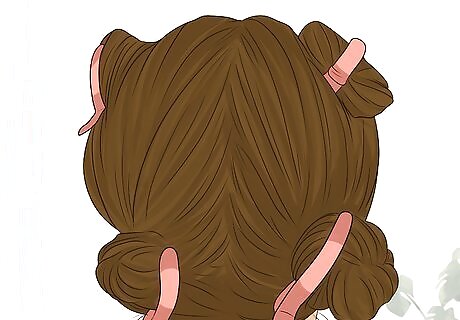
Divide your hair into sections. Henna is thicker than other types of hair dye, so it can be difficult to ensure that you spread it all over your head. Working with individual sections of hair makes it easier to saturate all of it. Gather all of your hair and clip it up, leaving only a small section, approximately 1-inch wide, to start with.
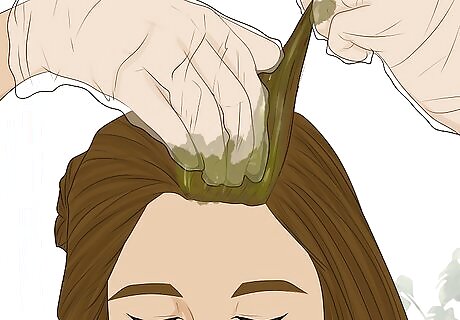
Apply the henna to each section of your hair. You want to really saturate the hair with the henna mixture, so don’t be afraid of applying too much. Take your time to ensure that you cover every strand with the henna too. Do your best to avoid getting henna on the sections that you’re not working on at the moment. Henna can tangle your hair very easily, which may make it harder to work with the other sections later. You can use a piping bag or squeeze bottle to apply the henna if you're having trouble controlling where it goes, but it's usually easier to use your fingers so you can really work it into your hair. For total coverage, apply the henna all the way up to your scalp. You may notice some slight staining, but it typically fades with a couple of hair washes. Because the thickness of henna can make it difficult to apply, you may want to ask a friend to help you color your hair, especially if you have long or extremely thick hair.

Cover your hair with a plastic cap or wrap. Henna is more effective when it’s kept warm, so covering the mixture as it sits on your head helps your red color turn out more vibrant. Check the henna package instructions to see how long you should leave it on your hair. It can take anywhere from one to six hours, but the longer that you leave it on, the deeper your red will be. Letting your henna sit on your hair for three to four hours will usually give you a nice, rich red color. If your natural color is dark, you may want to leave the henna on for six hours to ensure that you get a noticeable red hue.
Rinsing the Henna

Rinse the henna from your hair with warm water. You can remove it in the shower, but the henna may still stain your body as it’s washed away. Try rinsing it under the sink or tub faucet if you’re worried about the mess. Make sure that your gloves are on when you wash the henna out because it can still stain your hands too. You may need to rinse your hair a few times to get all of the henna out of your hair. Start rinsing with straight water. If you’re having trouble getting all of the henna out of your hair, you can use a gentle shampoo to help remove the residue. Using a shampoo can also help get fade the earthy scent of henna that may last for several days in your hair.

Allow your hair to air dry. You can use a towel to dry off your hair, but don't blow dry it because the heat may dry out your locks.
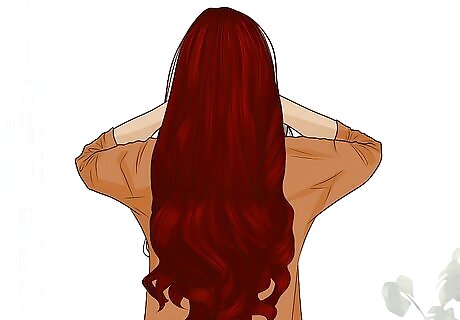
Don’t panic if your hair is extremely bright afterward. It’s normal for your hair to be a vivid orange or red right after you henna it. As it oxidizes, though, the color will deepen to a more natural shade of red. In fact, it can take up to three days for the true color to appear.
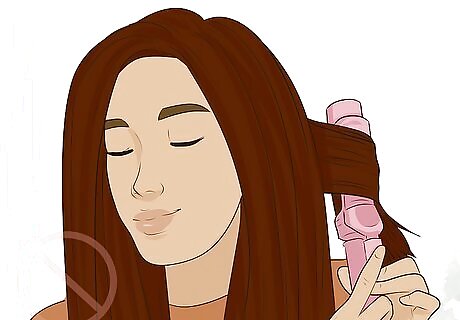
Be gentle with your hair. You don’t want to dry your hair out in the first week or so after you’ve applied the henna. Avoid harsh, clarifying shampoos, and don’t use heated styling tools, such as curling irons and flat irons.

Keep up your color. Henna is permanent, so it's not going to wash out of your hair after you've shampooed it enough times. However, your roots will start to grow eventually, so you'll need to reapply when you notice them to keep the color consistent. Because henna is actually good for your hair, you can use it as often as you'd like. It will help condition and boost the shine. When you're touching up your color, you can do a spot application and just apply the henna at the roots or cover all of your hair as a conditioning treatment.




















Comments
0 comment